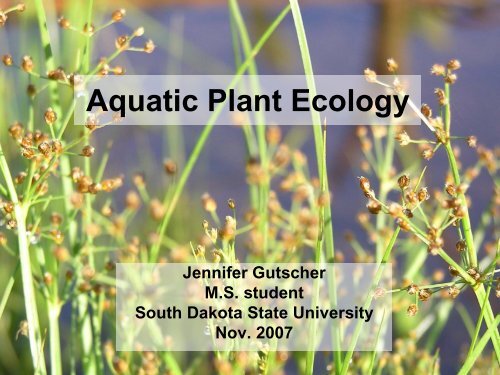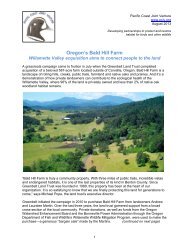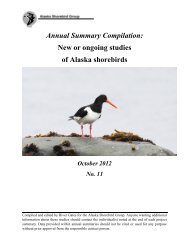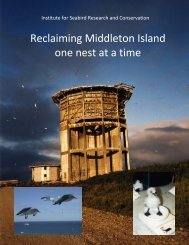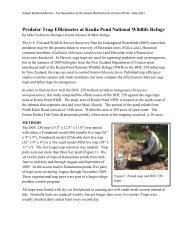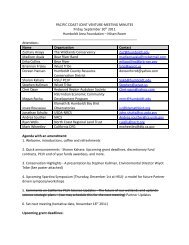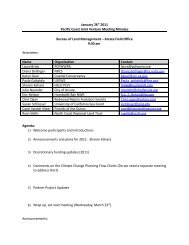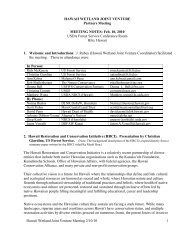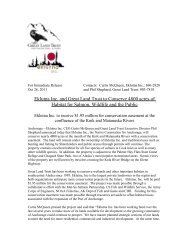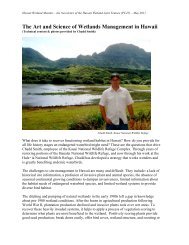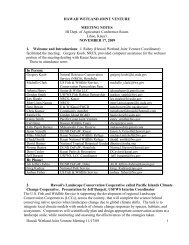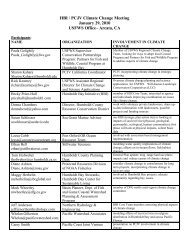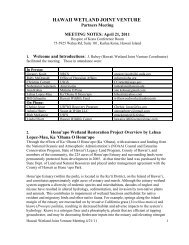You also want an ePaper? Increase the reach of your titles
YUMPU automatically turns print PDFs into web optimized ePapers that Google loves.
<strong>Aquatic</strong> <strong>Plant</strong> <strong>Ecology</strong><br />
Jennifer Gutscher<br />
M.S. student<br />
South Dakota State University<br />
Nov. 2007
<strong>Aquatic</strong> <strong>Plant</strong> <strong>Ecology</strong><br />
• Habitat<br />
• Classification<br />
• Major Families<br />
• Life History Strategies<br />
• Seed <strong>Ecology</strong><br />
• Abiotic & Biotic Influences<br />
• Competition<br />
• Exotic Species<br />
• Wetland <strong>Plant</strong> Adaptations<br />
2
What are <strong>Aquatic</strong> <strong>Plant</strong>s<br />
• “growing in water or on a substrate that is at least periodically deficient in oxygen as a<br />
result of excessive water content” (Cowardin et al. 1979).<br />
• Evolved from terrestrial plants, invading water in 50-100 separate events<br />
• Approximately 60% of aquatic species have ranges on more than one continent<br />
– Due to moderate environmental conditions in water habitats<br />
– Often on certain latitudes N & S of equator, but not between (waterfowl seed dispersal)<br />
• More than ½ of world’s wetlands are in tropical or subtropical areas<br />
• Endemics high in geographically isolated areas<br />
Bacopa monnieri<br />
3
• Roots<br />
– Stabilize sediments<br />
Wetland <strong>Plant</strong> Benefits<br />
– Can take up metals/pollutants out of sediments<br />
– Roots accumulate nutrients from sediments, release into water column<br />
• Senescence/decomposition & loss of organic compounds from<br />
tissues<br />
• Leaves<br />
– Evapotranspiration returns moisture to atmosphere<br />
– Floating-leaved plants can reduce evaporation off water surface<br />
• Reduce wave erosion on shorelines<br />
• Habitat & forage for invertebrates<br />
• Seed production for waterfowl<br />
• MANY OTHERS!!! Rhynchospora corymbosa<br />
4
• LAKES:<br />
– Lacustrine<br />
– Larger, deeper,<br />
more permanent<br />
– >2 m deep OR...<br />
– >8 ha in size<br />
– Classified by<br />
productivity of water<br />
zone, shape of basin<br />
and # times the<br />
water column mixes<br />
• WETLANDS:<br />
– Palustrine<br />
– Smaller, shallow, dry<br />
out occasionally<br />
– Only moist soil<br />
– Classified by<br />
hydroperiod,<br />
physiognomy (plant<br />
species structure),<br />
sediment types<br />
5
Littoral Habitat<br />
= Edge to limit of rooted aquatic<br />
plants (hydrophytes)<br />
Merritt & Cummins (1996)<br />
– Emergent<br />
• < 2 m deep<br />
• Cyperaceae (sedges), Poaceae (grasses), Juncaceae (rushes), Typhaceae (cattails)<br />
– Floating-leaved attached<br />
• < 4 m deep<br />
• Nymphaeaceae (water lily), Nelumbonaceae (lotus), Potamogetonaceae (pond weed)<br />
– Submerged<br />
• < 10 m deep<br />
• Most rooted, some free float in water column<br />
• Elodea (waterweed), Haloragaceae (water milfoil), Potamogetonaceae (pond weed), 6<br />
Ceratophyllaceae (hornwort), Lentibulariaceae (bladderwort)
Habitat<br />
Merritt & Cummins (1996)<br />
• Sublittoral<br />
– Small zone b/w littoral and profundal zone<br />
– Shade-tolerant plants<br />
• Limnetic<br />
– Open water from surface to where light does not penetrate<br />
– Free-floating<br />
• Lemnaceae (duckweed), Pistia stratoides (water lettuce), Eichhornia crassipes<br />
(water hyacinth)<br />
• Profundal<br />
– Deep water from limit of light penetration to bottom substrate<br />
7
Major <strong>Aquatic</strong> <strong>Plant</strong> Families<br />
• CYPERACEAE = Sedges<br />
– Monocot<br />
– Inflorescence = spikelets, usually<br />
surrounded by leaf-like bracts<br />
– Leaves = flat, 3 vertical rows,<br />
alternate, sometimes bladeless<br />
– Stem = trigonous, solid<br />
– Fruit = achene<br />
– Carex (sedge), Cyperus<br />
(flatsedge/nutsedge), Schoenoplectus<br />
(bulrush), Eleocharis (spikerush)<br />
• JUNCACEAE = Rushes<br />
– Monocot<br />
– Inflorescence = terminal<br />
– Leaves = flat to rounded with large vein<br />
divisions, 2 vertical rows, often all basal,<br />
often reduced or sometimes bladeless<br />
– Stem = round, solid<br />
– Fruit = 3-valved capsule, many seeded<br />
– Juncus (rush)<br />
“Rushes are round”<br />
“Sedges have edges”<br />
8<br />
Eleocharis obtusa
Major <strong>Aquatic</strong> <strong>Plant</strong> Families<br />
• POACEAE = Grasses<br />
– Monocot<br />
– Inflorescence = terminal, either panicle,<br />
spike, or rame<br />
– Leaves = flat, 2 vertical rows, alternate<br />
– Stem = round, hollow (except at nodes)<br />
– Fruit = grain<br />
– Agrostis (bentgrass), Urochloa mutica<br />
(California grass), Poa (bluegrass)<br />
• ASTERACEAE = Asters/Sunflowers<br />
– Dicot<br />
– Inflorescence = involucrate head<br />
(many little flowers = ray &/or disk<br />
florets), 1+ series of bracts<br />
– Leaves = variable<br />
– Fruit = achene with awns/bristles<br />
– Achillea (yarrow), Solidago<br />
(goldenrod), Erigeron (daisy fleabane)<br />
Ray<br />
Disk<br />
www.wikipedia.com<br />
www.wikipedia.com<br />
9
Major <strong>Aquatic</strong> <strong>Plant</strong> Families<br />
• POLYGONACEAE = Smartweeds<br />
– Dicot, annual<br />
– Inflorescence = raceme, terminal panicle,<br />
axillary clusters<br />
– Leaves = simple, alternate<br />
– Stems = swollen nodes with papery<br />
sheath<br />
– Fruit = trigonous or biconvex achene<br />
– Polygonum (smartweed)<br />
• LEMNACEAE = Duckweed<br />
– Inflorescence = rarely seen, tiny<br />
– Leaves = elliptic to oblong<br />
– Roots = hang into water column<br />
– Small to tiny plant<br />
– Free-floating<br />
– Lemna (duckweed), Wolffia<br />
(watermeal)<br />
Polygonum punctatum<br />
Lemna aequinoctialis (large) &<br />
Wolffia globosa (small)<br />
10
Flowering <strong>Plant</strong>s:<br />
Monocot vs. Dicot<br />
11<br />
www.images.encarta.msn
Spikerush<br />
Eleocharis obtusa<br />
MONOCOTS<br />
Nutsedge/Flatsedge<br />
Cyperus polystachos<br />
Climbing dayflower<br />
Commelina diffusa<br />
13
Primrose willow<br />
Ludwigia octovalvis<br />
DICOTS<br />
Valley redstem<br />
Ammania coccinea<br />
Water hyssop<br />
Bacopa monnieri<br />
15
EFFECTS OF MOWING<br />
GROWING POINT<br />
AT BASE<br />
GROWING POINT<br />
AT TIP<br />
MONOCOTS<br />
DICOTS<br />
16
Reproductive Strategies<br />
• Annuals<br />
– Early-successional species<br />
– Colonize disturbed areas devoid of vegetation<br />
– Complete life cycle in one year<br />
– Reproduce entirely by seed – Prolific!<br />
Cyperus difformis<br />
– Seeds remain in seed bank for many years<br />
– Bidens (beggarstick), Echinochloa (barnyard<br />
grass), Cyperus (flatsedge)<br />
17
Reproductive Strategies<br />
• Perennials<br />
– Survive few - many years<br />
– Reproduce by seed, vegetative means, or both<br />
• Shorter-lived species may reproduce entirely by seed<br />
• Most longer-lived species may reproduce by both seed<br />
and vegetative means<br />
– Colonize new areas by seed<br />
– Then, spread extensively by vegetative<br />
reproduction<br />
Sagittaria latifolia<br />
– Many can tolerate extended flooding<br />
• Aerenchyma tissues<br />
• Adventitious roots<br />
– Typha (cattail), Schoenoplectus (bulrush), Boltonia (aster),<br />
Sagittaria (arrowhead), Sparganium (burreed)<br />
19
Seed Bank<br />
• All viable seeds and/or propagules present on or in the soil or<br />
associated litter (Simpson et al. 1989).<br />
• # of spp. in seed bank reflects community diversity better than just what’s growing<br />
– Older wetlands tend to have more total seeds<br />
• BUT!...lots of variation b/w wetlands<br />
– Most seeds are long lived<br />
• Polygonaceae (smartweed), Schoenoplectus (bulrush), Typha (cattail),<br />
Chenopodium (goosefoot)<br />
• Cyclic hydrology (rather than stability) increases seed bank diversity<br />
• Wind, water, birds, fish, etc... disperse seeds<br />
• Sedimentation buries seeds deeper, some decompose<br />
– Seedlings from large seeds can push through soil better than small seeds<br />
21
Seed Bank<br />
• What’s in my seed bank<br />
– Take soil cores, allow germination in diff. abiotic conditions<br />
• Temp., drawdown rate, etc...<br />
– I.D. seeds from samples<br />
– Good to know for restoration projects<br />
• Inaccuracy<br />
– Some quickly predated<br />
– Microorganism attack<br />
• Bacteria<br />
• Fungi<br />
– Dispersal dependants decompose easily<br />
• Phragmites australis (common reed)<br />
– Many plants depend mostly on rhizomes/other asexual reprod. methods<br />
22
Size & Diversity of Wetland Seed Banks<br />
WETLAND<br />
TYPE<br />
DENSITY<br />
(x/m²)<br />
RANGE<br />
(m²)<br />
SPECIES<br />
RICHNESS LOCATION REFERENCE<br />
FRESH 29,753 10,875 - 36,230 45 IOWA VAN DER VALK<br />
AND DAVIS (1978)<br />
FRESH 110,000 42,000 - 255,000 50 IOWA VAN DER VALK<br />
AND DAVIS (1979)<br />
TEMPORARY 17,943 11,455 - 24,430 21 NEW JERSEY MCCARTHY (1987)<br />
BRACKISH 3,577 93 - 8,253 34 MANITOBA PEDERSON (1981)<br />
LAKESHORE 10,089 1,862 - 19,798 41 ONTARIO KEDDY AND<br />
REZNICEK (1982)<br />
RIVERINE<br />
SWAMP<br />
2,576 759 - 4,392 59 SOUTH<br />
CAROLINA<br />
SCHNEIDER AND<br />
SHARITZ (1986)<br />
SALT 191 50 - 430 3 UTAH KADLEC AND<br />
SMITH (1984)<br />
ADAPTED FROM LECK (1989)<br />
23
Dispersal Mechanisms of Seeds<br />
Animal<br />
Dispersal Agent &<br />
Adaptations<br />
Chemical attractant<br />
Clinging Structures<br />
Modification<br />
Hooks, Viscous material<br />
colored seed coat<br />
Comments<br />
Sticks to fur/feathers<br />
Eaten by birds<br />
Wind<br />
Size reduction<br />
High Surface/Volume<br />
Ratio<br />
Dustlike seeds<br />
Wings, plumes,<br />
Balloons<br />
Up to Millions/plant<br />
Balloons uncommon<br />
Water<br />
Resistance to sinking<br />
Uses surface tension<br />
Low specific gravity<br />
Hairs or slime<br />
Small Size, Unwettable<br />
Air spaces, Cork, Oil<br />
Submerged transport<br />
Float until wetted<br />
Float long distances<br />
25
Seed Longevity<br />
Species<br />
Age<br />
(years)<br />
Naturally<br />
Preserved<br />
Natural Field<br />
Conditions<br />
Location<br />
Lupinus arcticus<br />
(Arctic Lupin) 10,000 +<br />
Yukon Territory<br />
Chenopodium album 1,700 + Scandinavia<br />
Spergula arvensis 1,700 + Manchuria, Tokyo,<br />
Great Britain<br />
Nelumbium nucifera<br />
(Indian lotus)<br />
100 – 3,000 + Argentina<br />
Canna compacta 550 + Michigan<br />
Rumex crispus<br />
(Curled dock)<br />
Oenothera biennis<br />
(Evening primrose)<br />
80 + Michigan<br />
80 + Michigan<br />
Amaranthus retroflexus<br />
>30<br />
+<br />
Michigan<br />
Setaria media<br />
>30<br />
+<br />
Michigan<br />
Agrostis vulgaris<br />
Depth of burial<br />
• 3 cm deep<br />
• Can bring up seeds from<br />
inactive depths through<br />
tilling/discing/scraping<br />
28
What you see is not always<br />
what you have!
Seed Bank & Standing Veg. Species<br />
Diversity<br />
Wetland<br />
type<br />
Seed<br />
Bank<br />
Veg Total Location Reference<br />
Fresh 45+ 34 48 Iowa<br />
Van Der Valk &<br />
Davis (1978)<br />
Temporary 21 29 31 New Jersey<br />
McCarthy (1987)<br />
Brackish 29+ 18 35 Manitoba<br />
Pederson (1981)<br />
Lakeshore 41 45 50 Ontario<br />
Keddy &<br />
Reznicek (1982)<br />
Riverine<br />
Swamp<br />
59 49 73 S Carolina<br />
Schneider &<br />
Sharitz (1986)<br />
Salt 9 14 15 Utah<br />
Kadlec & Smith<br />
(1984)<br />
30
Using Seed Banks to Your Benefit<br />
Seed banks can be exploited to promote desirable vegetation communities<br />
Success depends on:<br />
1. Presence of seeds of preferred species<br />
2. Suitable conditions for germination and establishment of preferred species are<br />
met<br />
3. Absence of seeds of unwanted species, or these seeds are uncommon<br />
4. Conditions for germination and establishment of unwanted species are not met<br />
31
Hydrologic Germination Requirements<br />
• Each species responds to a unique combination of abiotic and biotic factors to break<br />
dormancy and/or germinate<br />
– Requirements can be very different from what mature plants can handle<br />
• Drawdown<br />
– Most all emergents<br />
– Potamogeton (smartweed), Fimbristylus littoralis (fimbry)<br />
• Flooding<br />
– A few emergents, i.e. Sparganium (burreed)<br />
– Most all submergents<br />
– Najas guadalupensis (Southern naiad)<br />
Fimbristylus littoralis<br />
• Wet meadow hardest to reestablish<br />
– Generally poor dispersers<br />
– PLUS, can’t persist in seed bank<br />
– Carex (sedge)<br />
32
Rock<br />
Lichen & Moss<br />
Weathering &<br />
Erosion<br />
Ferns<br />
Grasses<br />
Forbs<br />
Succession<br />
• Germination sets in motion a<br />
pathway of succession<br />
Annuals<br />
Perennials<br />
• IF NO DISTURBANCE:<br />
– Lower Seed Production<br />
– More Perennials<br />
– More Woody Vegetation<br />
Shrubs<br />
Seedlings<br />
Trees<br />
33
Influences on <strong>Aquatic</strong> <strong>Plant</strong><br />
Communities<br />
• Position in Landscape<br />
• Hydrology<br />
• Soils<br />
• Light<br />
• Temperature<br />
• Water chemistry<br />
• Seed bank<br />
• Competition<br />
• Other Biota<br />
34
Wetlands in the Landscape...<br />
Relationship with Hydrology<br />
Discharge<br />
Flow Through<br />
Recharge<br />
35
Recharge<br />
Wetland Types<br />
Discharge<br />
Flow-through<br />
36
Hydrologic Disturbances<br />
• Wet conditions<br />
– Submerged, floating-leaved, emergent plants, and algae<br />
• Dry conditions<br />
– Emergents, mud-flat annuals<br />
• What makes conditions change<br />
– Yearly/cyclical fluctuations in water quantity<br />
– Hydrologic disturbance of nearby river, lake, etc...<br />
– Floods<br />
• Can bring in new sediment, remove the old change vegetation community<br />
– Hurricanes/Tornados<br />
• Can create patchy network of vegetation<br />
– Water quality<br />
• Like pushing “reset” button on succession<br />
37
Typical Zone Vegetation<br />
• <strong>Aquatic</strong><br />
– Nearly continuous flooding at low elevations<br />
– Potamogeton (pondweed)<br />
• Marsh<br />
– Most flooded for majority of growing season<br />
– Fimbristylus (fimbry)<br />
Fimbristylus littoralis<br />
• Wet Meadows<br />
– Occasional flooding kills woody plants<br />
– Cyperus (nutsedges/flatsedges)<br />
Shrubs<br />
• Shrubs/Forested Wetlands<br />
– Periodic flooding (part of year – multiple years)<br />
– Not enough flooding to kill woody vegetation<br />
– Salix (willows)<br />
Marsh<br />
Wet<br />
Meadow<br />
Amplitude of<br />
long-term<br />
water<br />
fluctuations<br />
<strong>Aquatic</strong><br />
38<br />
Adapted from Cronk & Fennessy 2001
Wetland Hydrologic Controls<br />
• Stabilizing water levels (2 - 3+ yrs) can reduce plant species and community diversity<br />
– Significantly reduce emergent vegetation cover<br />
– Increase open water<br />
– Increase # & dominance of exotics/aggressive perennials<br />
• Typha (cattail) and Urochloa mutica (California grass)<br />
– Allow monospecific vegetation stands &/or one structural type<br />
– Decrease species richness<br />
– Decrease fungal or pollinator mutualistic relationships<br />
– Reduce or eliminate wet meadow and/or marsh zone<br />
Shrubs<br />
Marsh<br />
Wet<br />
Meadow<br />
Amplitude of<br />
long-term<br />
water<br />
fluctuations<br />
Shrubs<br />
<strong>Aquatic</strong><br />
<strong>Aquatic</strong><br />
39<br />
Adapted from Cronk & Fennessy 2001
Riverine Hydrologic Controls<br />
• Tropical rivers flood during “rainy season”<br />
– Riparian plant community composition dependant on physical disturbance<br />
• Intermediate disturbance hypothesis (Cronk & Fennessy 2001)<br />
– Too little disturbance “competitive exclusion tends to reduce diversity”<br />
– Too much disturbance “only highly tolerant species are able to persist”<br />
• <strong>Plant</strong> diversity also dependant on:<br />
– River discharge velocity<br />
– Stream order<br />
– Soils<br />
– Microtopographic relief<br />
– Upstream plant diversity<br />
40
Soils<br />
• Soil temperature<br />
– Affects germination<br />
• Soil Color<br />
– Can change with redox reactions<br />
• Microbes obtain O2 from mineral oxides = reduction<br />
– Indicates hydric soils<br />
• Soil Texture<br />
– Ribbon test<br />
– Gritty sand loamy silt soft, tight clay<br />
• Soil moisture<br />
– Capillary fringe<br />
• Rises higher with tighter pores<br />
• Found w/in 12” of soil surface = wetland<br />
– High organic content slippery feel, easily deformed<br />
41
Soils<br />
• Organic Content<br />
– Black, porous, light weight, smelly hydric<br />
• Methane & sulfide are smelly!!! redox rxn hydric soil<br />
• Residual <strong>Plant</strong> Material<br />
– Anoxic conditions slow plant decomposition<br />
• Soil Stratigraphy<br />
– Cognizant of horizons<br />
• Mineral composition helps control hydrology & water chemistry<br />
– Clay soils hold water<br />
– Sand lenses transmit water laterally<br />
– Hard Fe (iron) precipitate in HI bogs can cause ponding<br />
• Hydric soils – get down 45 cm (18”) to test<br />
• Soils become hypoxic within a few days of flooding anoxic<br />
42
Light<br />
• Most important factor for submerged plant distribution<br />
•
Light<br />
• Suspended solids, dissolved organic and inorganic compounds<br />
– Scatter light & absorb heat<br />
– Boat traffic, shoreline erosion, bottom feeding fauna, high wind action<br />
• Heavy periphyton coating can reduce productivity<br />
• Shading by other vegetation<br />
• Residual plant material<br />
• Time of Year<br />
– Day length<br />
– Intensity of light<br />
45
Temperature<br />
• Water<br />
– Fluctuations much less rapid and extreme<br />
• Increases “cosmopolitan species”<br />
– Phragmites australis (common reed), Lemna spp.<br />
(duckweed), Ceratophyllum demersum (hornwort/coontail)<br />
– High specific heat of water thermal stability<br />
– Solar radiation only reaches the uppermost few meters & affects...<br />
• <strong>Aquatic</strong> plants, O2, chemicals, aquatic insects, etc...<br />
• <strong>Plant</strong>s<br />
– Increase ET<br />
• Lose more H2O when open pores to intake CO2, exhale O2<br />
• Soil<br />
– Increase in temp. fluctuations can incite germination<br />
47
Water Chemistry<br />
• Soil & bedrock composition is huge influence<br />
• Higher pH, conductivity higher site fertility more spp. richness<br />
– pH<br />
• Increases during day use CO2 less carbonic acid (H2CO3)<br />
• Decreases at night opposite rxn.<br />
• Higher in urbanizing areas<br />
– Conductivity (μS/cm)<br />
• Total dissolved salts (TDS) or total dissolved ions<br />
• Increases with more evaporation (concentrates salts)<br />
• Bigger watershed more contact with soil before entering water <br />
more ions<br />
• Too many accumulated ions can be toxic<br />
–Ca 2+ , Mg 2+ , SO 4-<br />
, CO 3<br />
2-<br />
, HCO 3-<br />
, Cl - , Na +<br />
49
Water Chemistry<br />
• Dissolved gases<br />
– O2<br />
• Oxidated, hypoxic, or anoxic soils<br />
– Most plants require soil O2 levels high enough for respiration in<br />
order to germinate<br />
– Echinochloa crus-galli (barnyard grass) can germinate in anoxic<br />
conditions<br />
• Floating vegetation mats heavy shading reduces submerged<br />
vegetation/phytoplankton reduces O2<br />
• Decomposition increased O2 demand by bacteria reduced O2<br />
– CO2 sometimes limiting factor in submerged communities<br />
50
Water Chemistry<br />
Leptochloa fusca<br />
• Salinity<br />
– Brackish = 0.5 ppt (1.4% seawater)<br />
– Fresh water hard to obtain<br />
– Necessary ion uptake more difficult<br />
– CO 2 uptake difficult (opening stomata incurs water loss)<br />
– Reduces plant productivity<br />
– Toxic to freshwater plants<br />
• Can be used to your advantage!<br />
• Nutrients<br />
– Phosphorus tends to be limiting nutrient in oligotrophic systems<br />
• [N] = 1.5% (Cronk & Fennessy 2001)<br />
• [P] = 0.13%<br />
– Nitrates common in fertilizers/runoff<br />
• Pollutants<br />
– More in human land use areas<br />
– Ammonia, orthophosphate, chloride<br />
– Can change vegetation community<br />
51<br />
Batis maritima
• Trails form open water pathways<br />
Biotic Influence<br />
• Forage<br />
– <strong>Plant</strong> often dies b/c oxygen supply is cut off<br />
– Can change plant community<br />
• Decreases amount of certain species, allowing others to outcompete<br />
• Nesting materials<br />
– Wider less strands needed<br />
– Tougher less likely to break down<br />
– More aerenchyma floatation<br />
• Droppings increase plant productivity<br />
USFWS<br />
• Can increase open water habitat<br />
52
<strong>Plant</strong>s Compete Too!<br />
• The better competitors:<br />
– Make more biomass<br />
– Can gather nutrients when they’re at low levels (& still survive!)<br />
• However, high nutrient enrichment (eutrophication) decreases spp. richness<br />
– Exotics often win this competition<br />
• Increasing MICROtopography...<br />
– Increases heterogeneity<br />
– Increases # individual plants<br />
– Increases biomass<br />
– Reduces competition<br />
53
<strong>Plant</strong>s Compete Too!<br />
• Light<br />
– Floating-leaved plants can shade out submerged spp., esp. if high turbidity<br />
• Nymphaea (water lily)<br />
– Submerged spp. can form mats to shade out new growth from bottom<br />
• Ceratophyllum (hornwort)<br />
– Some emergent monocots reproduce vegetatively, shade out<br />
submerged/floating<br />
• Carex (sedge), Cyperus (flatsedge/nutsedge), Typha (cattail)<br />
• Nutrients<br />
– Ability to assimilate nutrients faster is advantage<br />
Nymphaea capensis<br />
54
Schoenoplectus juncoides<br />
<strong>Plant</strong>s Compete Too!<br />
• Space<br />
– Dense, monospecific stands produced by vegetative growth<br />
– Fire<br />
• Myriophyllum (water milfoil)<br />
• Increases space less aboveground standing stock reduces<br />
competition<br />
• Increases nutrient availability through oxidation (from plants to free in soil)<br />
• Maintains current stage or resets succession<br />
• Was it a part of natural regime<br />
• Deep water<br />
– Diffusive O2 flow to roots outcompeted by pressurized O2 ventilation<br />
• Pressurized in some spp. of Nymphaea (water lily), Eleocharis<br />
(spikesedge), Schoenoplectus (bulrush), Typha (cattail)<br />
– Skinny, tall leaves can be better in deep water than short, wide leaves<br />
55
• Competitors<br />
– Low disturbance<br />
– High productivity habitat<br />
– Low reprod. ability, high growth rate<br />
– Capture available resources well<br />
• Biomass storers<br />
– Low disturbance<br />
– Low productivity/low light/high<br />
salinity<br />
– High vegetative reproduction<br />
– Rhizomes/tubers store biomass<br />
and nutrients<br />
Elodea (waterweed)<br />
Typha (cattail)<br />
Carex echinata<br />
(star sedge)<br />
Polygonum punctatum<br />
(dotted smartweed)<br />
• Ruderals<br />
– High disturbance (not competitive)<br />
– High productivity habitat<br />
– High reprod. ability, fast growth, short life<br />
– Annuals - disperse!<br />
• Stress-tolerators<br />
– High disturbance<br />
– Low productivity habitat<br />
56<br />
– Low reprod. ability, low growth rate
• Secondary metabolic compounds<br />
– Root exudates<br />
– Leached from leaves or litter<br />
Allelopathy<br />
• Thought that chemicals are “expensive” to make, so usually “compete using<br />
only its physiological adaptations” (Cronk & Fennessy 2001)<br />
– Therefore, chemicals only produced under crowding stress<br />
• Cyperus (flatsedge), Eleocharis (spikesedge), Polygonum (smartweed),<br />
Nuphar (water lotus)<br />
57<br />
Nuphar (water lotus)
Why are Exotic Species so Competitive<br />
• Rapid regeneration through prolific seeds & vegetative reproduction<br />
– “The vegetative spread of submerged or floating species is most rapid in the<br />
tropics and where water levels remain constant” (Cronk and Fennessy<br />
2001).<br />
– Eichhornia crassipes (water hyacinth) can double areal extent in 3.5 days<br />
• Pests/herbivores not evolved to attack/consume exotic plant<br />
• Little competition from other plants<br />
– Native plants evolved to exploit separate niches<br />
– Exotics’ competitors rarely present in new range<br />
– Can grow quickly by capturing resources & light<br />
58
Why are Exotic Species so Competitive<br />
• <strong>Aquatic</strong> environment is relatively uniform<br />
• Wide ecological tolerances (generalists)<br />
– Can become dominant most anywhere if given the chance<br />
• Many are cosmopolitan (occur across the world)<br />
– Pistia stratoides (water lettuce)<br />
• Some resistant to fire, flood, drought<br />
Pistia stratoides (water lettuce)<br />
59
Exotic Species...<br />
• ...on Islands<br />
– Proportion of exotics on islands...up to 50%<br />
• Proportion of exotics on continents...up to 20%<br />
– Hawaii<br />
• Few plants colonized mostly evolved once they got here<br />
• Generally no frost would eliminate many exotics<br />
• Transportation stop b/w Asia & N.A.<br />
• ...on Disturbed areas<br />
– Very susceptible to invasion<br />
– Natural Fire, flood, drought, biota<br />
– Human<br />
• Damming/impoundment<br />
• Fragmentation<br />
• Urbanization<br />
• Pipes/irrigation/drains that change salinity<br />
• Climate change<br />
– Coastal areas<br />
– Weather pattern changes<br />
– Veg. movement towards poles<br />
60
Invasive Infestation<br />
• Change community structure<br />
– Rhizophora mangle (red mangrove) planted on Oahu<br />
• Shade out natives<br />
• Dense root system altered animal movements & community<br />
• Altered soil O2<br />
• Hybridize with natives<br />
– Can be more adapted, but just as invasive<br />
• Reduce seed bank diversity<br />
• Draw water level down with high evapotranspiration rates<br />
– Surface & ground water<br />
61
Invasive Infestation<br />
• Thick submergents<br />
– Provide refuge for fish fry, allowing high survival overpopulation,<br />
stunting<br />
– Hard for predator fish to hunt<br />
• Dense floating mats<br />
– Eichhornia crassipes (water hyacinth)<br />
• Inhibit O2 diffusion into water kill fish, invertebrates, plants<br />
• Accumulate heavy metals & toxic compounds ingestion can kill<br />
animal<br />
– Hard for chicks to maneuver<br />
• Alters fire regimes<br />
– Dry leaves of Arundo donax (Spanish reed) catch fire easily<br />
• BUT...plant is fire-tolerant<br />
62
Invasive <strong>Plant</strong> Growth Requirements<br />
Species<br />
American<br />
Lotus<br />
Common<br />
Reed<br />
Reed<br />
Canarygrass<br />
Broadleaf<br />
Cattail<br />
Narrowleaf<br />
Cattail<br />
Salinity pH range Propagated<br />
Tolerance<br />
None 4.59 – 7.40 Seed<br />
Low 4.50 – 8.0 Sprig<br />
Low 5.50 – 8.0 Seed and Sprig<br />
Low 5.50 – 7.50 Sprig<br />
Medium 3.70 – 8.50 Seed and Sprig<br />
63
Nuphar rhizome<br />
Biomass of Vegetatively<br />
Reproducing Perennials<br />
• Need to consider below ground biomass more!<br />
Mowing to cut off meristematic tissue is often not enough<br />
Must grub/scrape/dig to disrupt rhizomes/tubers<br />
Production (lb/acre)<br />
Species Common name Above Below<br />
Phragmites Common reed 9,580 64,060<br />
Typha Cattail 7,580 16,060<br />
Nuphar Water lotus 5,400 10,225<br />
65
Adaptations<br />
• Roots<br />
– Adventitious = laterally from main stem base into soil surface<br />
• In positions they normally don’t occur<br />
• Replace deep roots that die b/c anoxia<br />
• Stabilize & increase O2 to roots<br />
• Salix (willow), Rumex (dock)<br />
– Shallow rooting<br />
• Allows access to NO3- (nitrate), and O2<br />
– Prop & drop roots on red mangrove plants<br />
• Covered with lenticels for O2/CO2 exchange<br />
• Stability<br />
– Buttressed trunks<br />
• Jurassic Park<br />
Sagittaria latifolia<br />
• Stems<br />
– Elongation to access light, O2, CO2<br />
• Sagittaria latifolia (arrowhead)<br />
66
Adaptations<br />
• Rhizomes<br />
– Larger carbohydrate storage allows more ATP production for cell metabolism<br />
• More ATP needed in anoxia<br />
– Phragmites australis (common reed), Schoenoplectus (bulrush), Typha (cattail)<br />
• Aerenchyma = tissue with large intercellular spaces (lacunae)<br />
– O2 to roots, brings CO2 from roots & out stomata<br />
– May be 50-60% of root area in flood-tolerant plants<br />
– Stem floating to access light, O2, CO2<br />
– Swelling at stem base to enhance aeration<br />
– Some invertebrates tap into this to respire<br />
• Coleoptera larvae (Donacia sp. - Chrysomelidae)<br />
• Diptera larvae (Mansonia sp. – Culicidae<br />
& Chrysogaster sp. – Syrphidae)<br />
Schoenoplectus<br />
juncoides<br />
67
Adaptations<br />
Ludwigia palustris<br />
• Leaves<br />
– Some float off long stems, spread out to access light, O2, CO2<br />
– Heterophylly<br />
• Emergent leaves ovate/elliptic/rounded<br />
• Submerged leaves ribbon-like/dissected<br />
• Ludwigia palustris (marsh seedbox), Sagittaria (arrowhead)<br />
• Chemical defenses<br />
– Herbivory<br />
• Nymphaeaceae (water lily), Arundo donax (giant reed), Colocasia<br />
esculenta (taro)<br />
• Against invertebrates: Ceratophyllum (hornwort), many submergents<br />
68
Adaptations<br />
• Salinity<br />
– Increase internal solutes freshwater comes in<br />
Batis maritima<br />
– Exclude or secrete salts, leaf shedding, leaf/shoot succulence<br />
• Nutrients<br />
– Mycorrhizae = symbiotic fungi<br />
• Approx. 85% of all aquatic plants<br />
• Increases water, P, N, K + available for plant, takes carbohydrates from<br />
roots<br />
– N-fixing bacteria in root nodules<br />
• Sesbania (legumes), Alnus (alder), grey, white, and red mangrove plants<br />
– Move nutrients from aboveground tissues to roots, rhizomes, tubers, bulbs<br />
• Energy for start up next growing season<br />
69
Submergence Adaptations<br />
• Leaves<br />
– Chloroplasts in epidermis<br />
– Ribbon-like or highly dissected<br />
• More light to chloroplasts<br />
• More surface area for gas &<br />
nutrient exchange<br />
• Shoots can absorb water & nutrients<br />
• Less xylem & lignification<br />
• More aerenchyma<br />
– Buoyancy for proximity to light, O2, CO2<br />
– More gas transport<br />
• Dissolved bicarbonate (HCO 3- ) in photosyn.<br />
– Myriophyllum spicatum (Eurasian water<br />
milfoil)<br />
• Recycle CO2 from respiration into photosyn.<br />
– Elodea nuttallii (western waterweed)<br />
• Thin cuticle<br />
• No stomata<br />
– Gas exchange through diffusion<br />
70
Threats<br />
• Wetland loss<br />
– 50% loss on U.S. mainland<br />
– 1/3 T&E plant spp. in U.S. depend on wetlands<br />
• 30 T&E wetland plants in Hawaii alone<br />
• Hydrologic alterations<br />
– Agriculture<br />
– Groundwater drawdown<br />
– Flood control<br />
– Stabilized water levels<br />
• Altered topography<br />
• Pollution<br />
71
Threats<br />
Urochloa mutica<br />
• Exotic species<br />
– 20 spp. exotic biota introduced to HI/year<br />
– Monocultures less biodiversity<br />
– Extirpation of native species<br />
– Alter nutrient cycles<br />
– More invasives with more ecosystem degradation<br />
• Global climate change<br />
– Some wetlands will dry up (i.e. seasonal), others will expand<br />
– E.P.A. estimates 15-34 cm sea rise in next century (65 cm<br />
possible)<br />
72
Strategy<br />
• Monitoring<br />
• Limit Exotics & Perennials<br />
• Multiple Treatments<br />
• PATIENCE<br />
73<br />
H.Gee
HOW<br />
• Set Back Succession<br />
– Flooding/Drawdowns<br />
• Gradual basin slope ideal<br />
– Small drops in water level can expose large areas<br />
• Must understand water budget before flood/drawdown<br />
• Impact on invertebrates, waterfowl, other fauna<br />
– Tilling/Discing<br />
• Consider high degree of substrate disturbance<br />
– Mowing<br />
• Consider meristematic tissue (monocots vs. dicots)<br />
– Herbicides<br />
• Consider impacts on desired species<br />
• Get down to mineral soil<br />
74
THANK YOU!!!<br />
jennifer.gutscher@sdstate.edu<br />
75
Literature Cited<br />
• Cronk, J. K., and M. S. Fennessy. 2001. Wetland <strong>Plant</strong>s: Biology and <strong>Ecology</strong>. Lewis<br />
Publishers. Boca Raton, FL.<br />
• Erickson, T. A., and C. F. Puttock. 2006. Hawaii Wetland Field Guide. Bess Press<br />
Books. Honolulu, HI.<br />
• Larson, Gary. 2005. <strong>Aquatic</strong> <strong>Plant</strong>s. South Dakota State University. Brookings, SD.<br />
• Merritt, R. W., & K. W. Cummins. 1996. An Introduction to the <strong>Aquatic</strong> Insects of<br />
North America, 3 rd ed. Kendall/Hunt Publishing Company. Dubuque, IA.<br />
• Ward, J. V. 1992. <strong>Aquatic</strong> insect ecology, Vol. 1. John Wiley & Sons, Inc. New York,<br />
NY.<br />
***Thanks to Hugo Gee for many of the vegetation pictures<br />
76


